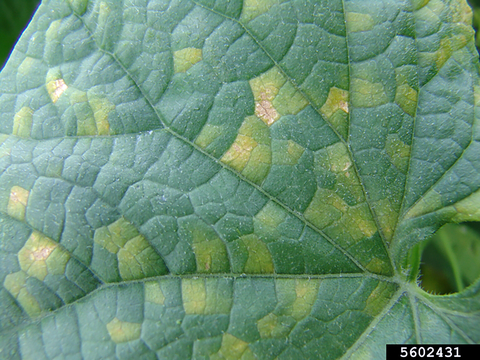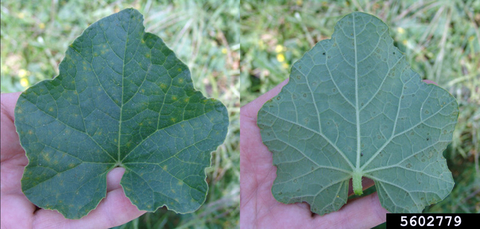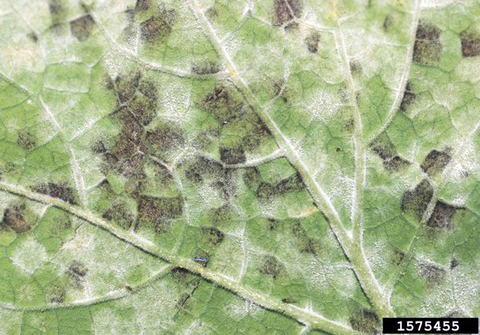Quick facts
- Downy mildew can infect all cucurbits but is most destructive in cucumbers and melons.
- The pathogen comes into our area on air currents from the south, but many years it never makes it to Minnesota.
- Once here, downy mildew can spread via air, splashing water, and on people’s tools and hands.
- It thrives in wet or very humid conditions.
- Yellow to pale green spots form on the upper side of the leaves, and on the underside, there is velvety grey fuzz.
- Angular leaf spot is often mistaken for downy mildew.
How to tell downy mildew from other cucurbit issues
- Pale green to yellow spots form on the upper surface of leaves, and later turn brown.
- Leaf spots are angular and bounded by leaf veins. This is most distinct in cucumber.
- Dark purplish-grey fuzz forms on the underside of the leaf in high humidity.
- In wet or very humid conditions, the disease develops rapidly.
- Leaf spots grow together and entire leaves turn brown. The leaves appear as if frost had killed them.
- On watermelons, an exaggerated upward leaf curling is common.
Biology
- Downy mildew (Pseudoperonospora cubensis) is not a fungus, but a water mold (like Phytophthora and late blight).
- There are two main races, one that infects cucumbers and melons, and one that infects pumpkins and squash. This means it is possible to see a healthy pumpkin field alongside a severely diseased cucumber field.
- Downy mildew does not create viable oospores (thick-walled resting structures) that would allow it to survive outdoors during Minnesota's harsh winter. It cannot survive on plant debris and only grows on living plant tissue.
- For downy mildew to occur in Minnesota, air currents must blow the spores from the South where it overwinters.
- In eastern states with similar conditions, downy mildew does not arrive until the end of the growing season, often in August. However, in some year’s downy mildew has arrived in the Midwest earlier in the season. This early infection is possibly due to a change in the pathogen's biology or due to greenhouse production of cucurbits that allows the pathogen to overwinter on living plants.
- Downy mildew can infect plants in a wide range of temperatures (41-86° F) but is most severe from 59-68° F. The pathogen needs moisture on the leaf surface in order to germinate and start a new infection.
- Under humid conditions, downy mildew rapidly reproduces and spreads, resulting in severe crop damage. The pathogen can move on air currents, splashing water and on the tools and hands of growers.
How to manage downy mildew in the home garden
Downy mildew isn’t seen in Minnesota most years. Compare what you are seeing to other diseases like angular leaf spot and powdery mildew. Plant resistant varieties if you’ve struggled with this disease in the past.
Other countermeasures include:
- Use drip irrigation and wide row spacing to dry the leaves and encourage good air movement around the plants.
- Trellis plants to improve air circulation.
- Remove plants with symptoms of disease.
- There are no effective pesticide products for downy mildew available to home gardeners.
How to manage downy mildew on farms
|
- Downy mildew is monitored by university researchers, and you can track where it is being found at the Cucurbit Downy Mildew iPipe Map.
- Monitor plants for symptoms of disease, especially from August through harvest.
- Plant resistant varieties when available.
- Cucumber varieties with moderate to high levels of resistance are available.
- Moderate to low levels of resistance are available for melons.
- Some resistant varieties are available for pumpkins and winter squash, but this is usually specific to certain variants of downy mildew and may not be effective in all cases.
- Use drip irrigation and wide row spacing to dry the leaves and encourage good air movement around the plants.
- Trellis to improve air circulation.
- For pesticide options, see the Midwest Vegetable Production Guide.
- There are resistance concerns around downy mildew, so make sure to follow labels carefully and rotate products.
CAUTION: Mention of a pesticide or use of a pesticide label is for educational purposes only. Always follow the pesticide label directions attached to the pesticide container you are using. Be sure that the area you wish to treat is listed on the label of the pesticide you intend to use. Remember, the label is the law.
Reviewed in 2022




